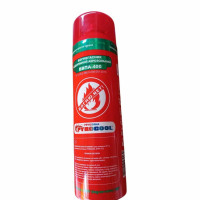When should you recharge a fire extinguisher? Complete instructions
- Thupm31Europe/Kiev 18:08:51
- Reviews: 0
- Views: 454
-

A fire extinguisher is a primary firefighting tool that must always be in working condition. However, many owners forget the necessity of periodic maintenance and recharging. Failure to perform these tasks on time can render the device useless in a critical situation. In this article, we will discuss how often a fire extinguisher needs to be recharged, the signs indicating maintenance is required, and who should perform this process.
Why Is Fire Extinguisher Recharging Important?
A fire extinguisher is a pressurized cylinder, and its functionality directly affects its effectiveness in extinguishing fires. Over time, the extinguishing agent can lose its properties, and the pressure inside the cylinder may decrease due to potential leaks. If recharging is not performed in time, the device may fail during an emergency.
Main reasons for recharging:
- The fire extinguisher has been used, even partially.
- The extinguishing agent has expired.
- A gas or liquid leak has been detected.
- A routine inspection has shown non-compliance with safety regulations.
- The extinguisher's body or mechanisms are damaged.
How Often Should a Fire Extinguisher Be Inspected?
Besides recharging, it is crucial to regularly inspect the fire extinguisher to identify possible malfunctions in time. It is recommended to:
- Conduct an external inspection every six months.
- Check the pressure gauge (if available) to ensure proper pressure levels.
- Inspect the hose and nozzle for any damage.
- Verify the seal and label indicating the last recharge date.
- Weigh CO₂ fire extinguishers – a weight loss exceeding 5% (or 50g) indicates a leak.
If any damage, corrosion, pressure reduction, or an expired recharge date is found during the inspection, the fire extinguisher must be immediately sent for maintenance.
How Often Should a Fire Extinguisher Be Recharged?
The recharging frequency depends on the type of fire extinguisher and its operating conditions:
- CO₂ (Carbon Dioxide) Fire Extinguishers – recharge every five years. An annual weight check is required. If the weight loss exceeds 5%, an unscheduled recharge is necessary.
- Powder Fire Extinguishers – recharge every two years (unless the manufacturer specifies otherwise). Fire extinguishers used in vehicles or humid environments require annual recharging.
- Foam and Water Fire Extinguishers – mandatory recharge every year.
- Air-Emulsion Fire Extinguishers – recharge at least every five years, following the manufacturer's recommendations.
Who Should Perform Fire Extinguisher Recharging?
Recharging a fire extinguisher requires specialized knowledge, equipment, and materials. Only certified organizations with licenses for fire safety equipment maintenance can perform this service. Attempting to refill a fire extinguisher independently is unacceptable, as incorrect recharging can lead to malfunction or even depressurization of the cylinder.
After recharging, a label indicating the next scheduled maintenance date must be affixed to the extinguisher. Additionally, the information is recorded in a fire safety equipment log.
Recharging vs. Buying a New Fire Extinguisher: Which Is More Cost-Effective?
Many owners face the dilemma of whether to recharge an old fire extinguisher or purchase a new one. Here are the key factors to consider:
- Cost. Recharging is generally more affordable than buying a new unit, especially if the extinguisher's body and mechanisms are in good condition.
- Service Life. The average lifespan of a fire extinguisher is 10-15 years. If an extinguisher is over ten years old, replacing it may be more reasonable.
- Condition of the Body. If corrosion, damage, or leak traces are present, purchasing a new device is a safer option.
- Technical Features. Modern fire extinguishers may offer improved properties, such as a longer-lasting extinguishing agent.
Liability for Delayed Recharging
For organizations and businesses, failing to maintain fire extinguishers on time can lead to fines. Depending on the country and regulations, violations of fire safety requirements can result in administrative or even criminal liability. It is essential to keep track of recharge dates and periodic technical inspections.
Recommendations for Fire Extinguisher Storage and Use
To extend the service life of a fire extinguisher and minimize the risk of malfunction, follow these simple rules:
- Store in a dry, well-ventilated area, away from direct sunlight and heat sources.
- Periodically weigh CO₂ fire extinguishers – weight loss may indicate a gas leak.
- Regularly inspect the body for damage – if deformations or rust appear, an urgent technical inspection is necessary.
- Ensure easy access to the extinguisher – it should be in an accessible location, not hidden in a cabinet or behind furniture.
Recharging a fire extinguisher is not just a technical procedure but a vital safety measure. Every fire extinguisher requires periodic maintenance, and neglecting this rule can have severe consequences. Keep your fire extinguisher in good condition, conduct timely inspections, and trust only qualified professionals for recharging. Remember, a properly functioning fire extinguisher can save lives!
Вогнегасник ВВК-1,4 (OУ-2)
Вогнегасник СО2 переносний місткістю балона 2 літри (1,4 кілограма вогнегасної речовини), призначени..
₴0.00грн
Вогнегасник ВВПА-450 М
Даний вогнегасник ВВПА 450 М (морозостійкий) - це новітня розробка, що гасить пожежі за рахунок особ..
₴0.00грн







